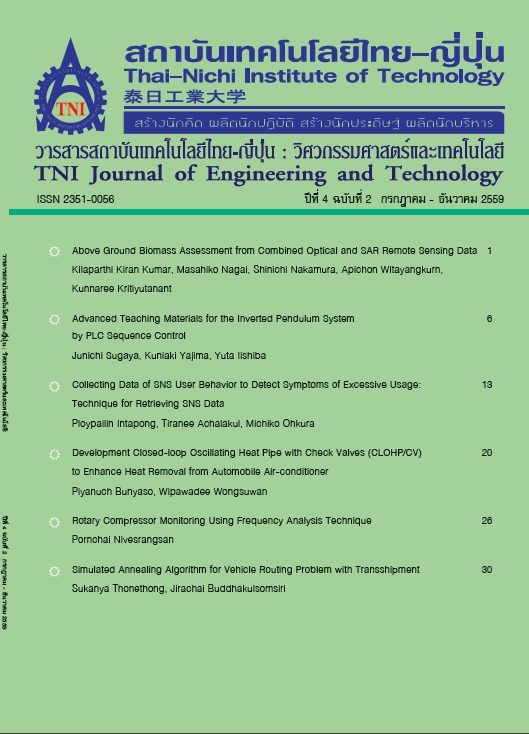The Design of Experiment to Determine the Optimum Parameters for Air Particles Control in the Head Gimbals Assembly (HGA) Washing Process
Main Article Content
Abstract
The aim of this research is to increase the quality of the Head Gimbals Assembly (HGA) by reducing the particle contamination of the washing process in the Cleanroom. Six factors have been identified and the experiments have been conducted. The six factors are 1) the air velocity of the fan filter, 2) the width of the air return, 3) the holes’ diameter of the washing machine table, 4) the height of the air ionizer, and 6) the suction force of the exhaust. The Box-Behnken Experimental Design has been used to identify the significant effect of each factor. A Response Surface Methodology (RSM) technique was then applied to determine the proper configuration of each factor. The optimal setting obtained from the experiments are as follows: 1) the air velocity of the fan filter unit (FFU) should be 105 feet per minute (fpm), 2) the width of the Air Return should be 1 centimetre (cm), 3) the Holes’ diameter of the washing machine table should be 3 millimetres (mm), 4) the effect of the height of the air ionizer is not significant, and 5) the suction force of the Exhaust should be 300 fpm. The mathematical analysis showed that the amounts of size 0.3 microns (µm) particle are reduced from 4,392 to 57 Counts per cubic foot (Counts/ft3) and the amounts of size 0.5 µm particle are reduced from 1,323 to 1 Counts/ft3, respectively, which are conformed to the operating standard required by the US Federal Standard 209E. The confirmation production run then conducted and it’s shown that the actual amounts of size 0.3 and 0.5 µm particles obtained are 68 and 17 Counts/ft3, respectively. This is expected to help reducing defect and increase quality in the production of components in the hard disk drive.
Article Details
Article Accepting Policy
The editorial board of Thai-Nichi Institute of Technology is pleased to receive articles from lecturers and experts in the fields of engineering and technology written in Thai or English. The academic work submitted for publication must not be published in any other publication before and must not be under consideration of other journal submissions. Therefore, those interested in participating in the dissemination of work and knowledge can submit their article to the editorial board for further submission to the screening committee to consider publishing in the journal. The articles that can be published include solely research articles. Interested persons can prepare their articles by reviewing recommendations for article authors.
Copyright infringement is solely the responsibility of the author(s) of the article. Articles that have been published must be screened and reviewed for quality from qualified experts approved by the editorial board.
The text that appears within each article published in this research journal is a personal opinion of each author, nothing related to Thai-Nichi Institute of Technology, and other faculty members in the institution in any way. Responsibilities and accuracy for the content of each article are owned by each author. If there is any mistake, each author will be responsible for his/her own article(s).
The editorial board reserves the right not to bring any content, views or comments of articles in the Journal of Thai-Nichi Institute of Technology to publish before receiving permission from the authorized author(s) in writing. The published work is the copyright of the Journal of Thai-Nichi Institute of Technology.
References
T. Lin, Y.-C. Tung, S.-C. Hu, and Y.-J. Chen, “Experimental study on airflow characteristics and temperature distribution in non-unidirectional cleanrooms for electronic industry,” Building and Environment, vol. 46, no. 6, pp. 1235–1242, Jun. 2011.
“Cleanroom Classifications,” Data Recovery Salon, 2015. [Online].Available: https://www.datarecoverytools.co.uk/data-recovery- vocabulary/vocabulary-a-e/clean-room.
“Box-Behnken Designs for Optimizing Product Performance,” Reliability HotWire, 2015. [Online]. Available: https:// www. weibull.com/hotwire/issue130/hottopics130.htm.
D. A. Raj and T. Senthilvelan, “Empirical Modelling and Optimization of Process Parameters of machining Titanium alloy by Wire-EDM using RSM,”Materials Today: Proceedings, vol. 2, no. 4, pp. 1682–1690, Jan. 2015.
J.-J. Chen, C.-H. Lan, M.-S. Jeng, and T. Xu, “The development of fan filter unit with flow rate feedback control in a cleanroom,” Building and Environment, vol. 42, no. 10, pp. 3556–3561, Oct.2007.
M. Ebrahimi, F. Mahboubi, and M. R. Naimi-Jamal, “RSM base study of the effect of deposition temperature and hydrogen flow on the wear behavior of DLC films,” Tribology International, vol. 91, pp. 23–31, Nov. 2015
C. Y. Khoo, C.-C. Lee, and S.-C. Hu, “An experimental study on the influences of air change rate and free area ratio of raised-floor on cleanroom particle concentrations,” Building and Environment, vol. 48, pp. 84–88, Feb. 2012.
T. Xu, “Characterization of minienvironments in a clean room: Design characteristics and environmental performance,” Building and Environment, vol. 42, no. 8, pp. 2993–3000, Aug. 2007.


